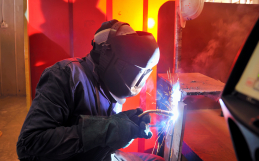The pairing of jigs and fixtures sounds like an odd combination of a comic book character and household goods. They are an all-around team that is consistently used in machining.
Here is an overview of what jigs and fixtures are and how they are used.
The Jig
During machining, some jobs can be done quite simply. Others are more complicated and require additional tools to carry out the procedure. In many more complex operations, a device is needed to guide the tool used to do the job. The jig is what guides the tool.
It is a lightweight device that both positions and holds the work. It is what guides the cutting tool about the work component. It is not usually attached to the machining table while it does its job. Jigs are commonly part of the drilling, tapping, rearming and counter boring jobs in machining.
The most widely used are drill and boring jigs, which describes the operations where they are used. Jigs are also categorized by their construction. Open and closed jigs are essential to every shop. Open jigs include template jigs, plate jigs, table jigs, and sandwich jigs. Closed jigs include box jigs, leaf jigs, and channel jigs.
The Fixture
The fixture holds the tool, to correctly position it, but it doesn’t guide it, position it or locate it. Fixtures are used in applications where it is more difficult to guide a cutting tool than it is a drill. It is clamped or otherwise attached to the machine table. It is heavy and solid, so it can efficiently position the tool.
Fixtures are commonly used for turning, grinding, milling, planing, shaping, and boring. Common types include the lathe fixture, milling fixture, grinding fixture, and sawing fixture.
Benefits of Jigs and Fixtures
Jigs and fixtures are used in a wide range of machining, inspection and assembling operations. They don’t carry out specific machining operations. Instead, they help other devices carry out their purpose, whether it is drilling, tapping, boring or something else.
They let heavy, complicated, and intricate parts be efficiently machined by holding them rigidly to the machine. Even labor that isn’t highly skilled can produce faster and with higher accuracy when jigs and fixtures are part of the process. In effect, these devices partially automate a machine tool.
Jigs and fixtures establish a relationship between the work and the cutting tool, ensuring that the predetermined tolerance can always be met. Because they ensure that the same operation happens over and over again, they remove the need for a special setup for each task.
They help produce interchangeable parts, where every piece is made within the same established tolerance. The result is faster and more precise manufacturing at a lower cost. They also increase worker safety and reduce accidents.
Call the experts at CE Metals today, with experience in all types of metal fabrication, let them give you the help you need with your metal fabrication project!





